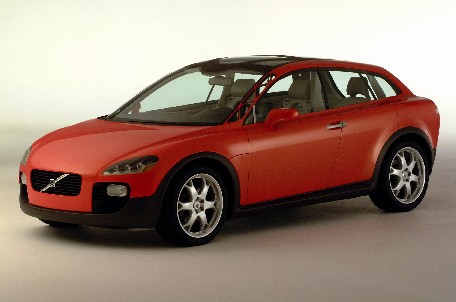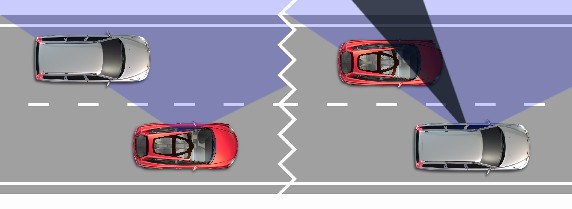How often have you heard of men behaving like a child with a new toy? Well… guilty as charged, your Honor!

I’m sitting in the SCC – Volvo’s new ‘Safety Concept Car’ – bemused by the nature of some remarkable features and their sheer quantity.
“Giving drivers the best possible view is what this car is all about,” says Dan Johnston, a veteran of thirty-five years working for Volvo, USA. “When you get into it, sensors detect where your eyes are; then the car molds itself around you. The floor, the pedals, the seat height, the steering wheel, and even the center console all move until the car senses that you are in the best possible position.”
Before I can say ‘Really?’ it happens, and it feels delightfully weird – but it seems more like being in a spaceship than a dentist’s chair. I’ve paid good money for custom-tailored suits that didn’t fit me as well as this Volvo does.
Dan draws my attention to the pillars that hold the roof and – usually – have the windows in place. The so-called ‘A-Pillars,’ at either side of the windshield, are transparent – made of a crisscross metal framework filled with Plexiglas or some such substance. This will allow drivers at intersections a much better view to either side, especially in connection with bicyclists and motorcyclists, many hundreds of whom have been killed over the years by unthinking or unseeing drivers pulling out of a drive or a side street in front of them.
“Now look over your shoulder,” says Dan.
No matter how hi-tech the see-through front pillars are, the ‘B Pillars’ – between the front and rear doors – are much more startling. They are not there!
There is no metal column between the glass of the front side windows and the rear side windows. Instead, the solid frame, which is essential to help hold up the roof in the event of a rollover-type crash, is built into the outside edge of each of the front seats, several inches inboard from the windows, and it is curved inwards, allowing the driver a remarkable, uninterrupted view when checking over his shoulder. And this, of course, is another reason that the controls move to the driver rather than the other way around; the edge of the seat is part of the safety frame, so it isn’t going anywhere.

(The red car is the SCC, and the silver car is any other!)
Am I impressed so far? Suffice it to say that the see-through ‘A Pillars’ and the see-around ‘B Pillars’ would easily be reason enough for me to buy this car. Safe driving – whether it be of the modest but very worthwhile standard known as ‘defensive driving’ or of the full-blown police ‘advanced’ standard, which requires a total of several hundred hours of specialist training – depends to a significant extent on precisely what can be seen at any given moment, and then using every ounce of that visual information to interpret both the road ahead and the actions of all other road users. That is why you will never see an excellent driver with a string of beads, a crucifix, or an air freshener-Christmas-tree-thingy dangling from their interior mirror. Nothing is allowed to block any part of the view of a wise driver, let alone stuff that swings around in a distracting, eye-catching way. The maximum idea is always vital, and the Volvo SCC delivers it in truckloads.
So much for the extreme, outstanding views afforded to drivers by the design of the ‘A-‘ and ‘B-Pillars’ on the SCC; yet, in many ways, these are seemingly the two most straightforward innovations. Let’s look at some other aspects.
Imagine walking towards your car in the middle of a deserted parking lot at night. Want to know whether a thug is lying in wait inside the vehicle? Press a button on the remote control; sensors will pick up the heartbeat of anybody in the car and warn you well before you arrive. If all is well, you get into the car and start the engine, but you do it courtesy of your fingerprint; gone are the days of a key.
Okay, now you are safely inside and heading home in the dark. Let’s say that after you leave behind the busy intersections in town, the road has lots of curves and steep grades. Press a button: up pops an infrared night-vision screen to extend your view beyond the range of the headlights. This isn’t a first; several makes of cars around the world already have this feature, but the Volvo doesn’t just have passive infrared. A close look at the headlight array on the front of the car shows three small fresnel lenses inside each headlight, fed via fiber optic cables. Apart from providing normal headlight illumination, these lenses do something entirely different.
When you drive slowly, the light beam automatically brightens and widens nearer your car to help you with town-driving situations. On the open road, the shaft lengthens to give you better distance vision as you build up speed. But then – get this – when you drive around tight curves and corners, part of the beam swings left or right as you start to turn the wheel so that you can actually see around the bend in advance, and not just the portion of it that you happen to be on at that moment.

This car has cameras, too; one to replace the interior rear-view mirror if you are carrying too much luggage in the back and you block your view out of the rear window; one to show you the ground directly behind the car when you are backing up; and one – especially for frustrated moms (and dads) – to show you the kids in the back seat, so that you can yell at them without turning your eyes away from the road!

These cameras, and their two viewing screens, are good but, again, not revolutionary. Once more, the adjacent technology breaks new ground – the car has sensors. Yes, there is one to tell you whether you are driving too close to the vehicle ahead, but there are sensors fixed to each of the side mirrors as well, and these trigger warning lights if there is another vehicle on either side of your car, in a rear blind spot. That’s great; it’s a valid and obvious warning, but the next bit is even better: If you fail to see the warning lights and you intend, say, to change lanes to pass a vehicle ahead, then the moment you switch on your indicator as though you were going to pull across in front of the car in your blind spot, the Volvo lets you know that this is a bad idea. And it does let you know; I learned this first-hand during a pre-arranged situation on the test drive. By now, one of the Swedish engineers is in the car with me. She can’t resist grinning and commenting at my reaction: “What is this ‘Bloody Hell!’ that you English say?”
The other new type of sensor does something somewhat different. The staff at Volvo – in their remarkable, unique, eighty-million US-dollar safety research center – are well aware of all the major causes of fatal road crashes worldwide, one of which is unintentionally drifting from one lane to another or even drifting right off the road. This is usually linked to drowsiness or just plain lousy concentration. But if you attempt to do a gradual drift between lanes (or head, accidentally, off the road altogether) in the Volvo SCC and haven’t given a signal to show that you intend to move sideways, then it’s time to wake up.
Think about wartime submarine movies when a klaxon sounds and a stressed voice shouts, ‘Dive, dive, dive!’ Well, alright… it’s not quite like that, but the noisy result would encourage a drowsy driver to wake up rather swiftly.
What else is there? Let’s pause for thought. We all think of vehicle occupants whenever car manufacturers talk about better safety. Still, of course, the people on the outside are often most at risk: pedestrians die even when struck at relatively low speeds. But it is a misnomer whenever you hear talk of someone being knocked down by a car, People hit by cars are almost always knocked upward, not down. Their legs are swept out from underneath them by the front bumper, and the unfortunate person’s head usually hits the windshield. And that alone often kills them. This is why windshield wiper hubs are now located below the hood’s level – to stop them from punching a hole in the skull of some poor unfortunate passer-by.
But now, Volvo – and their relatively new owner, Ford – are jointly working on this problem. The Volvo SCC is fitted with a ‘cowl’ airbag between the rear edge of the hood and the windshield. The bag triggers in the event of a relevant type of collision on the front bumper and cushions the head of a pedestrian or bicyclist from hitting the glass. On the other hand, Ford is working on the concept of an over-the-hood airbag that will trigger at the very front of the car a split second before a collision with a pedestrian to protect the person from the front metalwork of the vehicle.
Stephen Rouhana, who leads the Advanced Occupant Protection group at Ford, tells me of the difficulties of setting sensors to detect a pedestrian’s legs but not fire if, for example, the car hits a cardboard box. He is most excited about the new, easy-fit four-point seat belts fitted to the Volvo SCC.
It was, after all, Volvo that invented three-point seatbelts back in 1958. So it can be no surprise that the car manufacturer that has effectively always led the world in safety now shocks even the informed with an incredible display of engineering and innovation on the concept car. Whether Ford bought Volvo three years ago purely for diversification or whether they purchased the marque to lift themselves to the forefront of vehicular safety is academic. Still, every car manufacturer worldwide has much to learn from these Swedes.
Oh, and the looks? Volvos used to attract much criticism years ago that they were ugly – those days have long gone. The current models from the Volvo stable are among some of the most attractive family and executive cars on the road. Who could criticize the looks (or performance) of the C70, for example? So now you can have the best of both worlds, maximum safety and a good-looking car. The first ever Volvo SUV is coming out this fall (2002), too, and I can’t wait.
Meanwhile, all the Swedish engineers must do is drag me out of the SCC because I’m not for leaving. So may I take it home, please?
All photographs © Volvo Cars of North America
